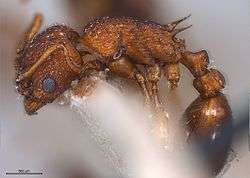Myrmica salina
| Myrmica salina | |
|---|---|
 | |
| M. salina worker specimen | |
| Scientific classification | |
| Kingdom: | Animalia |
| Phylum: | Arthropoda |
| Class: | Insecta |
| Order: | Hymenoptera |
| Family: | Formicidae |
| Subfamily: | Myrmicinae |
| Tribe: | Myrmicini |
| Genus: | Myrmica |
| Species: | M. salina |
| Binomial name | |
| Myrmica salina Ruzsky, 1905 | |
| Synonyms[1] | |
| |
Myrmica salina is a species of ant belonging to the genus Myrmica. They have a wide distribution in Europe and Siberia, as well as being abundant to several former republics of the Soviet Union, where their preferred habitats are relatively wet halophyte biotopes. Ruzsky first described the first specimen of the species in 1905.
Taxonomy
M. Ruzsky first described the first M. salina specimen in 1905.[2] The taxonomic history for M. salina is complicated as the type specimens have been presumed to be lost, and the original description of the species was ambiguous.[3] Since being described, the ant has three synonyms, being Myrmica scabrinodis ahngeri, by Karavaiev in 1926, Myrmica georgica by Seifert in 1987, and more recently in 2004, with Myrmica tobiasi by Radchenko and Elmes.[1]
Description
The appearance of M. salina is similar to that of the ants Myrmica scabrinodis, but in comparison to its other relative, Myrmica slovaca, its appearance is much different.[3] The description on the M. salina below is based off the original publications of Ruszky, as well as comments mentioned in Radchenko and Elmes' (2010) publication:
The descriptions of M. slaina ants were based on worker, queen and males collected from various places in Siberia and Kazakhstan.[2][3] Worker ants had an average length of 4.7-5 mm in length, with brownish-red colors, along with dark brown or blackish-brown head dorsum and first gastral segment. The antennae, mandibles, leg, apex and gaster are of a lighter color.[2] Queens and males are of a same size, usually around 5-6 mm in length. The queen has similar features to the workers, with the exception of its color appearance much darker than its worker counterparts, as well as its antennal scape thickening in the middle.[2]
Distribution
M. salina has been observed only in wet and damp habitats, usually seen foraging or even nesting in halophyte and biotope environments, in which these habitats were studied in West Siberia and Kazakhstan.[3] Their type habitat is salt marsh, where they nest in soil and under rocks, in grass turf, mostly lasine soil.[4] The distribution of M. salina is mainly in Central Europe and East Europe, where they are found in the European countries of Austria,[5] Czech Republic,[6] Slovenia,[7] Croatia,[8] Romania[9] and Russia (also found in the Asian part of Russia), while in Asia (notably countries of the former Soviet Union) they are found in Georgia,[10] Kyrgyzstan[11] and Kazakhstan.
Etymology
From medieval Latin, salina is translated to "salt pan", or salted place derived from the Latin word salis, which means salt. The name describes the ants type habitat "salted marsh".[3]
References
- 1 2 Seifert, Bernhard (2011). A taxonomic revision of the Eurasian Myrmica salina species complex (Hymenoptera: Formicidae) (PDF). Soil Organisms & Section Pterygota, Senckenberg Museum of Natural History. pp. 171 – 172. Retrieved 14 September 2014.
- 1 2 3 4 Ruzsky, M. 1905b. The ants of Russia. (Formicariae Imperii Rossici). Systematics, geography and data on the biology of Russian ants. Part I. [In Russian.]. Trudy Obshchestva Estestvoispytatelei pri Imperatorskom Kazanskom Universitete 38(4-6):1-800. [1905] 128184
- 1 2 3 4 5 Radchenko, A. G.; Elmes, G. W. 2010. Myrmica ants (Hymenoptera: Formicidae) of the Old World. Fauna Mundi 3. Warsaw: Natura Optima Dux Foundation, 790 pp. [2010-12-15]
- ↑ "Species: Myrmica salina". antweb.org. AntWeb. Retrieved 14 September 2014.
- ↑ Steiner, F.M.; Schödl, S.; Schlick Steiner, B.C. (2003). Checklist of the ants of Austria (Hymenoptera: Formicidae), as at October 2002. (PDF) (in German). Vienna: Beiträge zur Entomofaunistik. p. 21. Retrieved 14 September 2014.
- ↑ Werner, Petr; Wiezik, Michal (2007). Acta Entomologica Musei Nationalis Pragae: Vespoidea: Formicidae (mravencovití) (PDF) (in Czech). Supplementum. p. 140. Retrieved 14 September 2014.
- ↑ Gregor Bracko, 2003. New species for the ant fauna of Slovenia (Hymenoptera: Formicidae). Natura Sloveniae 5(1): 17-25
- ↑ Gregor Bracko, 2006. Review of the ant fauna (Hymenoptera: Formicidae) of Croatia. Acta Entomologica Slovenica 14 (2): 131-156.
- ↑ Czekes, Zolt; Radchenko, Alexander G.; Csősz, Sándor; Szász-Len, Annamária; Tăuşan, Ioan; Benedek, Klára; Markó, Bálint (2012). The genus Myrmica Latreille, 1804 (Hymenoptera: Formicidae) in Romania: distribution of species and key for their identification (PDF). Entomologica romanica. p. 1st page. Retrieved 14 September 2014.
- ↑ N. Gratiashvili & Sh. Barjadze, 2008. Checklist of the ants (Formicidae Latreille, 1809) of Georgia. Proceedings of the Institute of Zoology, Tbilisi XXIII: 130-146.
- ↑ Roland Schultz, Alexander Radchenko & Bernhard Seifert, 2006. A critical checklist of the ants of Kyrgyzstan (Hymenoptera: Formicidae). Myrmecologische Nachrichten 8: 201-207.
External links
-
 Data related to Myrmica salina at Wikispecies
Data related to Myrmica salina at Wikispecies